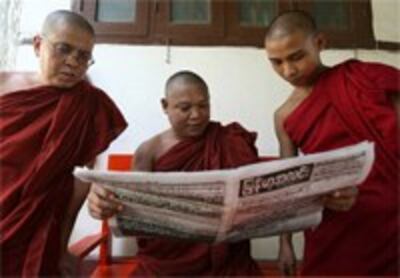
BANGKOK—A standoff between Burmese authorities and hundreds of Buddhist monks in the central city of Pakokku has ended with the release of 13 officials taken hostage by the monks after government forces violently suppressed an earlier demonstration.
Monks angry at being beaten with truncheons in the crackdown took 13 local officials captive in a compound before burning a number of government vehicles in front of thousands of onlookers, witnesses said.
“The monks told them [onlookers] not to join in, as they didn’t want to get people into trouble, but some of the people helped them turn the cars upside down before they burned them,” one resident said.
Witnesses said 500 monks marched peacefully through the town ahead of the military intervention, chanting prayers and holding placards, with local people offering them bottles of water.
It was broken up by government troops and hired thugs of pro-government groups, who blocked the monks’ way, pointing guns at the unarmed protesters and firing shots into the air, before setting upon them with truncheons and rifle butts, residents said.
When the monks ran, their attackers rounded them up using rope lassos, one monk told RFA. At least one young monk was severely injured. “They were throwing ropes to catch the monks like cowboys. Two monks who got caught with a rope round their neck and later were released now have injuries on their neck and cannot eat because of the pain,” one monk said.
“Two monks were tied to a lamppost with rope and beaten,” he added.
The monks took reprisals overnight by destroying the electronics store owned by Hla Win Naing, secretary of the township branch of the pro-junta USDA group that helped organize the crackdown on Wednesday, residents said.
Monks retaliate
Monks mostly from the city’s East Monastery also marched to and destroyed the house of Khin Maung Win, also a USDA member, they said.
U Tay Zaw, the head of the local Sangha Monastic Council who initiated the crackdown under intense political pressures, had fled his monastery and was believed to be in hiding, they added.
The inclusion of the monks in the [1988] protest gave people a huge amount of courage. It showed a general population-wide support for the movement, and it gave it a real anchor in the society in general.
The protest was the largest gathering of monks since anti-government protests erupted after a sharp rise in fuel prices in mid-August.
In 1988, said Brian Joseph, director for South and Southeast Asia at the National Endowment for Democracy, monks played a critical role. They are credited with helping to rally popular support for the uprising, which was put down with deadly force, killing hundreds and perhaps thousands of people.
“The inclusion of the monks in the [1988] protest gave people a huge amount of courage,” Joseph said. “It showed a general population-wide support for the movement, and it gave it a real anchor in the society in general.”
Pakokku, a seat of Buddhist learning is home to an estimated 10,000 young monks studying in more than 80 monasteries. The vast majority of the population in Burma is Buddhist.
Junta aims blame
Government-run Rangoon TV Myanmar meanwhile criticized the monks for resorting to violence. “They should not have engaged in violence by destroying and setting fire to cars,” it said, accusing overseas dissident groups of inciting people to oppose the government.
In opposition to what they have said, they have now engaged in violent acts. It seems that they are intentionally trying to incite the people in order to create unrest like in 1988.
“Under the pretext of protesting against a rise in fuel price, members of the so-called 'the 88 generation' and the National League for Democracy party said in their statements and verbal communication and through foreign media that their protests are nonviolent and peaceful in nature,” the report said.
“In opposition to what they have said, they have now engaged in violent acts. It seems that they are intentionally trying to incite the people in order to create unrest like in 1988.”
The junta also took aim at foreign players for what it described as incitement.
“They’re trying to blame it on the outside, on the exile community, because it is a typical Burmese trait to resent external influence on their affairs,” former U.S. charge d’affaires in Burma Priscilla Clapp said. “For the regime to be blaming external influence on the monks is quite absurd. And of course nobody believes that.”
Original reporting by Ko Ko Aung and Sein Kyaw Hlaing for RFA’s Burmese service. Additional reporting by Richard Finney in Washington. Service director: Nancy Shwe. Executive producer: Susan Lavery. Written for the Web in English by Luisetta Mudie. Edited by Khin May Zaw and Sarah Jackson-Han.
